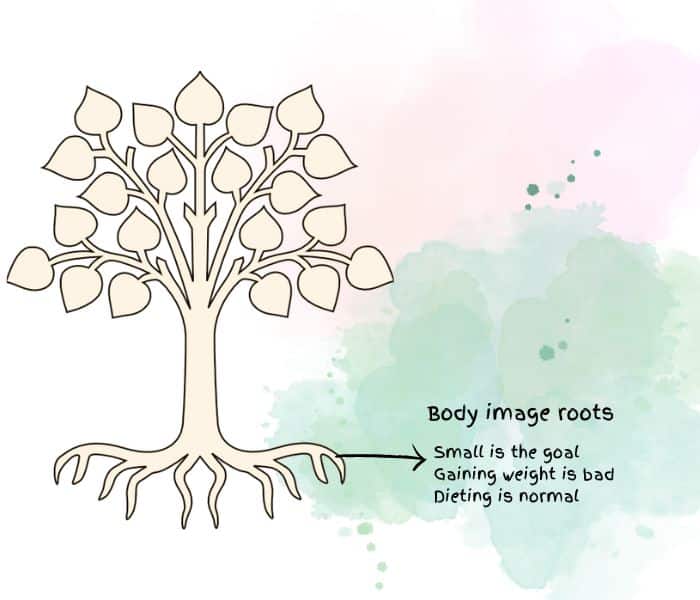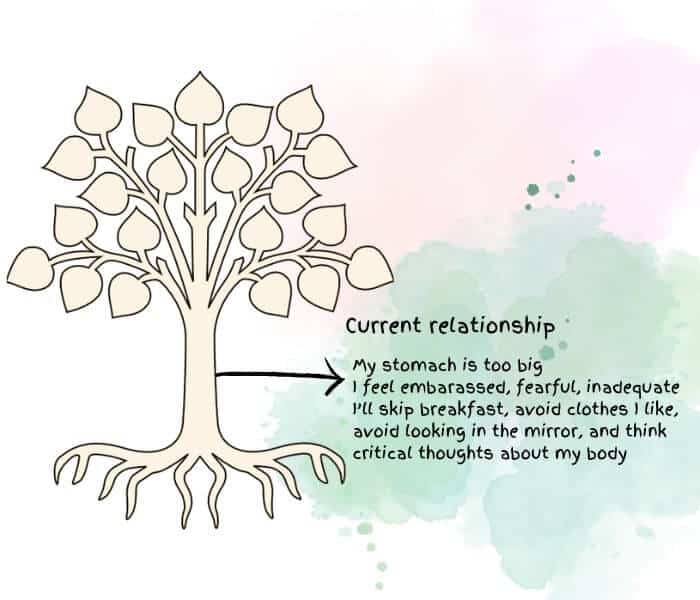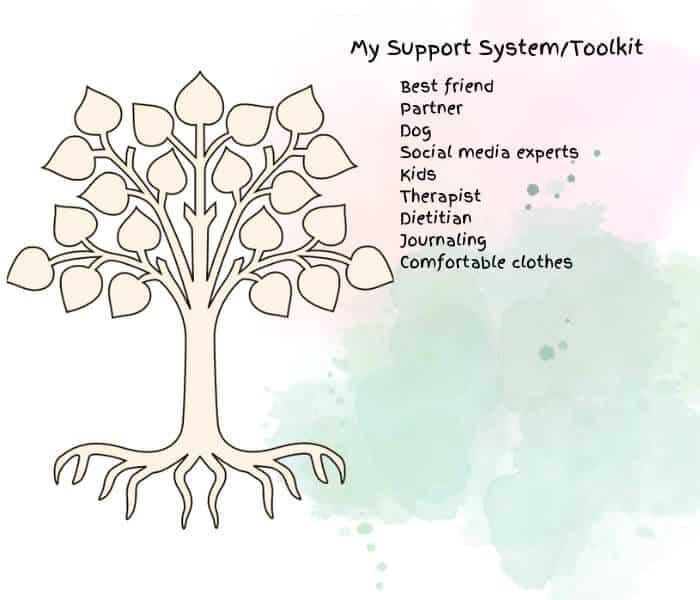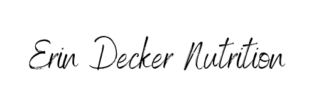Cultivating a positive body image while healing your relationship with food is a difficult but important step in your journey to food freedom. It is hard to give up dieting when you are in constant fear of what will happen to your body!
It’s true that body image may improve with weight loss. However, I have found that this is fleeting. When we tie our self worth to societal ideals it is never grounded in true self acceptance. Instead, we are always waiting for and fearful of when our body will change.
Shifting toward body and size acceptance helps us make peace with food because we aren’t so tied to how the food will change our body.
The relationship between dieting and body image
The relationship between dieting and body image is complex. We end up in a chicken-or-egg situation. Is the poor body image a result of the diet? Or are we dieting because of poor body image? Maybe both? There are several scales that have been validated to measure body image, but they all have their limitations, such as age group and cultural variations.
I’ve rarely met a client who had a good relationship with their body and still wanted to change their eating. Don’t get me wrong – it happens. Usually it stems from a medical problem that we are conditioned to believe weight loss will improve. But most of the time, it’s pursued because body image needs support.
And let me emphasize that this is not about vanity! There’s nothing wrong with wanting to change your body. We live in a society that constantly tells us that thin, white, young, able bodies are the most valuable. Of course we all struggle with body image at one point or another.
Thomas Cash, PhD, one of the first researchers on body image, describes the relationship between body image, dieting, and disordered eating. A poor body image can inspire someone to go on a diet, which can lead to disruptions in eating like restriction, binge eating, and engaging in the diet cycle. The problems build over time and eventually can develop into an eating disorder, or at least a skewed relationship with food and body. These situations themselves can fuel poor body image. It is a vicious cycle.
Intuitive eating is an approach to fueling your body that relies on internal hunger and fullness cues. Rather than dieting, this approach is associated with improved self esteem and body acceptance.
There is no doubt that improving your body image is fundamental to healing your relationship with food, and perhaps even the opposite is true. Intuitive eating has certainly helped me work toward body acceptance. It is much easier to care for something you appreciate rather than hate!
The following steps will help you understand your current relationship with your body and steps you can take to cultivate a more positive body image. They are steps that I have learned and practice myself from Ashley Emmons, LCMHC.
Step 1: Understand your body image story
The first step to cultivating a positive body image is to understand your body image story. This is the foundation of your body image, influenced by cultural and societal standards and past experiences.
If it feels safe for you, find somewhere quiet and private. Get out a journal or a sheet of paper and brainstorm some answers to the following questions:
- What sort of messages did you receive about your body?
- What did the media (TV, social media, magazines, etc.) tell you about your body?
- What did parents, teachers, coaches, friends, and family say about bodies?
- Had you received any messages from churches, schools, clubs, teams, or other organizations?
This practice helps you understand the roots of your body image story with curiosity and compassion. You were not born with these thoughts and feelings. They stem from somewhere.

Step 2: Understand your current relationship with your body
The next step is to understand your current relationship with your body. This is all influenced by the early messages you received and messages you are currently receiving today.
What thoughts do you have about about your body?
What feelings does it bring up for you?
How do you respond to these thoughts and feelings? Restriction? Overeating? Body checking, punishing exercise, critical thoughts? Avoidance?

Step 3: Describe your ideal relationship with your body
The next step is to brainstorm your ideal relationship with your body.
- What do you want it to look like?
- If your body image was better, how would your life be different?
- If you knew your body wouldn’t change, how would you live your life?

Step 4: Identify your support system/toolkit
Next, identify your support system. This can be people, places, pets, groups, media, etc. that support you in your journey. Make a list of everyone and everything that supports you on your journey to your “ideal”. Such as:
- Family, friends, and pets
- Counselor or dietitian
- Support groups
- Social, Church, neighborhood groups
- Social media influencers
- Books and websites

Step 5: Shift the needle
Lastly, recognize that body acceptance doesn’t come overnight. If we’re looking at a scale of 1-10, and you’re starting at a 2-3, we might try to shift the needle to a 5. We’re not trying to get to body love, but rather starting with respect and acceptance.
I like to draw a spectrum with my clients to document their own journey. See the example below. Make note of where you’re at today, where you want to be, and then document your journey on a daily, weekly, and monthly basis. Take note of what thoughts and feelings you have at each interval. You can see that body image can vary widely on a day-to-day basis.

Overcoming challenges
Challenges happen. I have a whole blog post about overcoming body image issues. It might take some introspection to figure out what works for you.
For me, it is helpful to remember that body changes are really just a bandaid. Weight loss might feel better in the moment (HELLO thin privilege) but at the end of the day it doesn’t actually improve my self image. Instead, there might be a fear of when my body will go back to its previous state.
It may also be helpful to remember that over the long term, dieting doesn’t work. We have very limited options when it comes to permanently altering the size of our bodies, and dieting may actually lead to weight gain.
And sometimes, just sitting in the uncomfortable reality that you don’t like your body is progress. You don’t need to love or even like your body in order to nurture it.
Cultivating a positive body image takes time, patience, and tons of self compassion.
Conclusion
Cultivating a positive body image is hard work, but is an important step on the journey to healing your relationship with food. I use these steps personally as well as in session with my own clients.
Sign up for my newsletter for more body image and intuitive eating tips!

testing